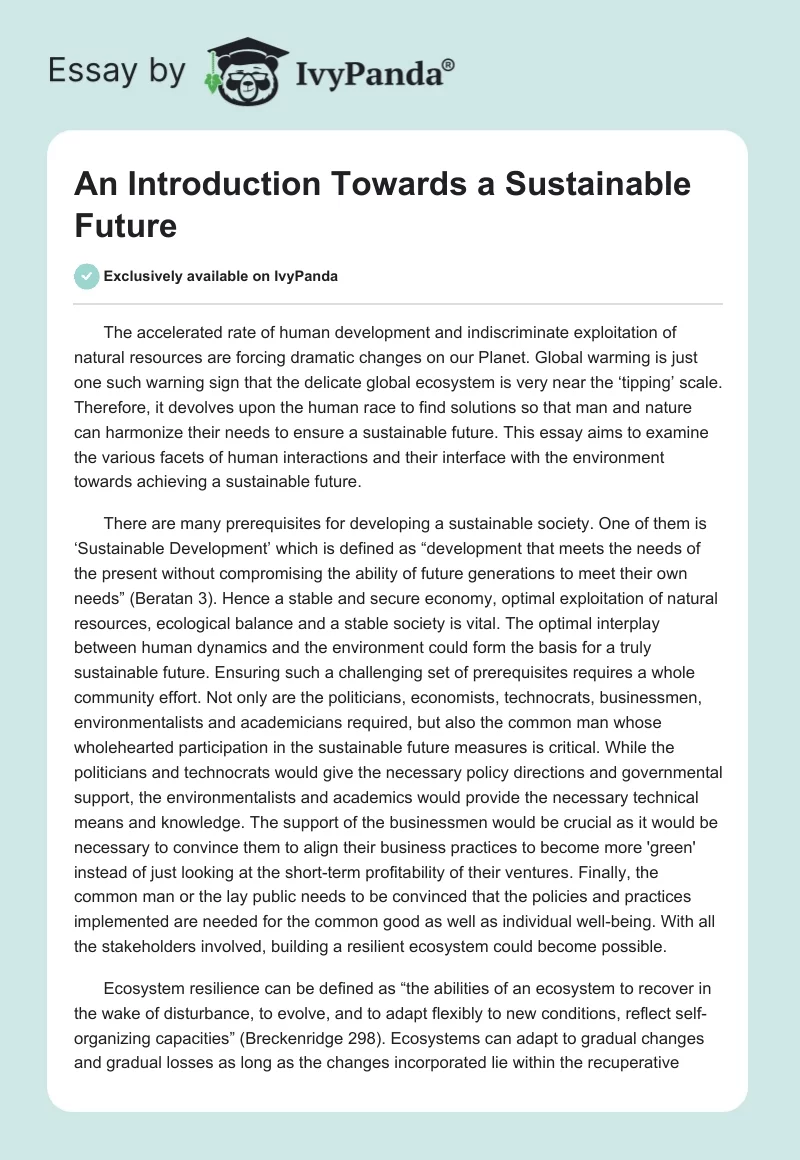The accelerated rate of human development and indiscriminate exploitation of natural resources are forcing dramatic changes on our Planet. Global warming is just one such warning sign that the delicate global ecosystem is very near the ‘tipping’ scale. Therefore, it devolves upon the human race to find solutions so that man and nature can harmonize their needs to ensure a sustainable future. This essay aims to examine the various facets of human interactions and their interface with the environment towards achieving a sustainable future.
There are many prerequisites for developing a sustainable society. One of them is ‘Sustainable Development’ which is defined as “development that meets the needs of the present without compromising the ability of future generations to meet their own needs” (Beratan 3). Hence a stable and secure economy, optimal exploitation of natural resources, ecological balance and a stable society is vital. The optimal interplay between human dynamics and the environment could form the basis for a truly sustainable future. Ensuring such a challenging set of prerequisites requires a whole community effort. Not only are the politicians, economists, technocrats, businessmen, environmentalists and academicians required, but also the common man whose wholehearted participation in the sustainable future measures is critical.
While the politicians and technocrats would give the necessary policy directions and governmental support, the environmentalists and academics would provide the necessary technical means and knowledge. The support of the businessmen would be crucial as it would be necessary to convince them to align their business practices to become more ‘green’ instead of just looking at the short-term profitability of their ventures. Finally, the common man or the lay public needs to be convinced that the policies and practices implemented are needed for the common good as well as individual well-being. With all the stakeholders involved, building a resilient ecosystem could become possible.
Ecosystem resilience can be defined as “the abilities of an ecosystem to recover in the wake of disturbance, to evolve, and to adapt flexibly to new conditions, reflect self-organizing capacities” (Breckenridge 298). Ecosystems can adapt to gradual changes and gradual losses as long as the changes incorporated lie within the recuperative range of the ecosystem. Moment the change wrought is disruptive beyond the recuperative range, an ecosystem fails. For example, if the felling of trees in a rainforest is controlled at a rate at which the rain forest can regenerate lost foliage, the ecosystem will recover. However to give shape to such recuperative measures requires adherence to principles such as stewardship.
Stewardship implies that everyone in this world has a responsibility to other people and the world. Stewardship in business encompasses ethical management of all activities involved in production, use and disposal of goods produced which includes a responsibility to ensure safe handling throughout the life cycle of the product in use. This means conforming to the ethics, not taking shortcuts, following the laws of the land in letter and spirit, inculcating sustainable practices and promoting awareness to customers, employees, and the general public. In governance, the concept of stewardship is of paramount importance. It is important for the political class to understand that implementing sustainable policies involves practicing supportive politics. For example, a governmental policy to ban smoking should not be held hostage to the political pressure from the Tobacco lobby.
The recent trends in ensuring a sustainable future are now encompassing all aspects of human endeavor. These include using green technologies and green architecture to incorporating conservation methods and recycling for buildings, houses and business practices as also green transportation. The concept of Corporate Social Responsibility (CSR) is defined as “the continuing commitment by business to behave ethically and contribute to economic development while improving the quality of life of the workforce and their families as well as of the local community and society at large” (KPMG 7) has gathered greater momentum.
The international community now is no longer leaving sustainability to the realms of academic discussions but is taking measures by which conservation and optimum utilization of resources are promoted proactively. This is being done by enacting strict country-specific environmental protection laws as also voluntary enactments which enhance brand value. The World Wildlife Fund recommends that ensuring a sustainable future would involve, tackling climate change, ensuring food and water security and drawing up a plan for sustainable resource management (WWF 2).
These are just some of the initiatives that require to be taken. In the conclusion it can be emphatically stated that humanity’s future will depend on its ability to form global consensus on matters relating to sustainable exploitation of the resources, evolving best practices, policies and laws governing all human activities so that future generations have a self-generating resilient global ecosystem which will provide the requisite physical, food, water, health, economic and social security.
Works Cited
Beratan, Kathy K. “Pointing Pennsylvania Toward a Sustainable Future.” 2006. Web.
Breckenridge, Lee P. “Can Fish Own Water?: Envisioning Nonhuman Property in Ecosystems.” Journal of Land Use Vol 20:2.2005. 293-335.
KPMG. “Corporate Social Responsibility –Towards a Sustainable Future.” 2009. Web.
WWF. “Leading the World Toward a Safer and Sustainable Future: Greenprint for a New Administration.” 2009. Web.


